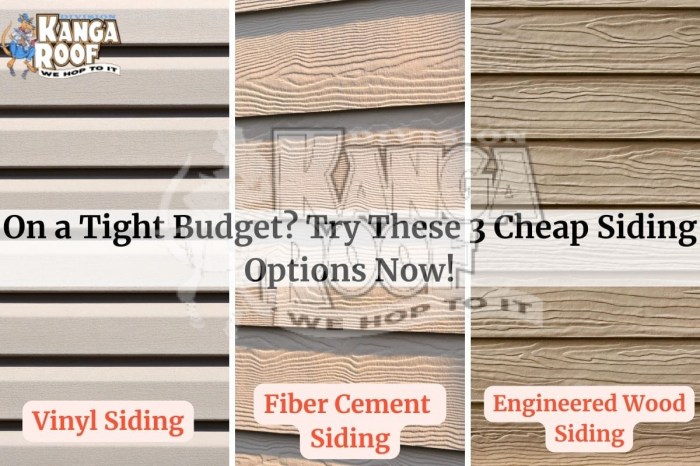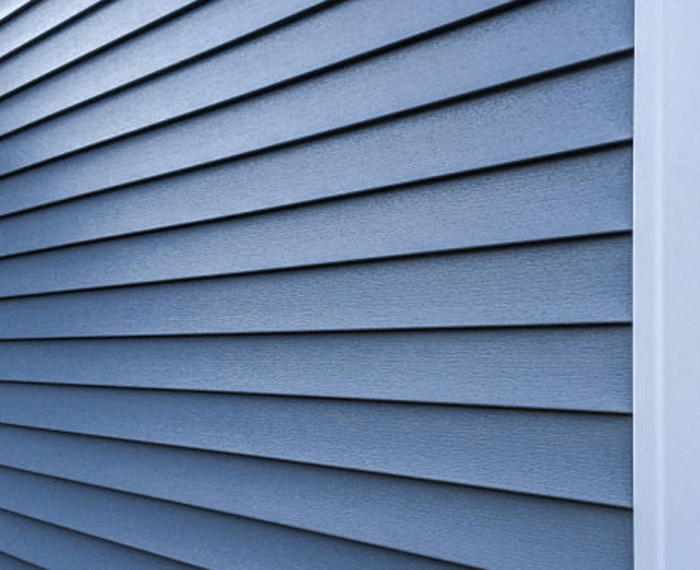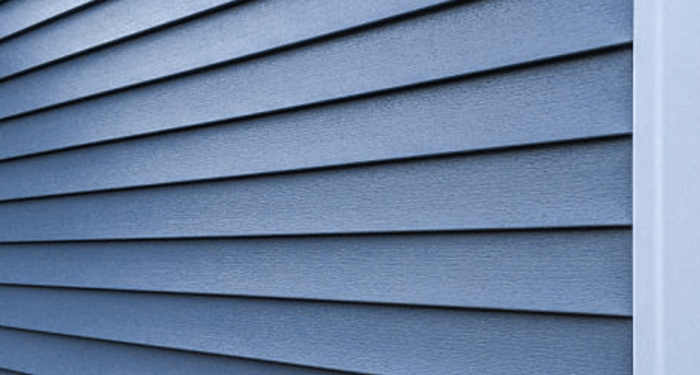Diving into the realm of affordable home siding options, this introduction sets the stage for a comprehensive discussion on different materials, costs, energy efficiency, and installation methods. With a blend of informative details and engaging insights, readers are in for an enlightening journey through the world of home siding options.
Providing a detailed look at the various types of siding materials available and their unique characteristics, this guide aims to equip homeowners with the knowledge needed to make informed decisions about their property's exterior.
Types of Affordable Home Siding Options
When it comes to choosing affordable siding options for your home, there are several materials to consider. Each type of siding has its own benefits and drawbacks, so it's important to weigh your options carefully before making a decision.
Vinyl Siding
- Benefits: Vinyl siding is one of the most affordable options available and comes in a wide range of colors and styles.
- Drawbacks: It may not be as durable as other materials and can crack or fade over time.
- Durability: Vinyl siding is generally low maintenance and can last up to 20-40 years with proper care.
Fiber Cement Siding
- Benefits: Fiber cement siding is durable, resistant to fire, insects, and rot, and can mimic the look of wood or stucco.
- Drawbacks: It can be more expensive upfront compared to vinyl siding.
- Durability: Fiber cement siding is known for its longevity and can last up to 50 years or more.
Engineered Wood Siding
- Benefits: Engineered wood siding is more affordable than natural wood and is available in various textures and finishes.
- Drawbacks: It may require more maintenance compared to other materials and can be prone to moisture damage.
- Durability: With proper maintenance, engineered wood siding can last up to 20-30 years.
Metal Siding
- Benefits: Metal siding is durable, low maintenance, and can provide a modern look to your home.
- Drawbacks: It can be prone to dents and scratches, especially in areas prone to severe weather conditions.
- Durability: Metal siding is known for its longevity and can last up to 50 years with minimal maintenance.
Wood Siding
- Benefits: Wood siding provides a classic, natural look and can be easily painted or stained to match your home's aesthetic.
- Drawbacks: It may require more maintenance to prevent rot, mold, and insect damage.
- Durability: Properly maintained wood siding can last for decades, but it may need regular upkeep to maintain its appearance.
Cost Comparison of Siding Materials

When considering siding options for your home, it's important to take into account the cost of materials. Different siding materials come with varying price tags per square foot, which can impact your overall budget for the project.Factors that can impact the overall cost of siding installation include the size of your home, the complexity of the design, the need for additional insulation, and the labor costs in your area.
These variables can significantly affect the final price you pay for siding installation.
Cost Per Square Foot Comparison
| Siding Material | Cost per Square Foot |
|---|---|
| Vinyl | $3-$8 |
| Wood | $6-$12 |
| Fiber Cement | $5-$10 |
| Aluminum | $5-$9 |
The quality of the siding material can also impact long-term costs. While some materials may have a higher upfront cost, they could require less maintenance and last longer, ultimately saving you money in the long run. Consider the durability and maintenance requirements of each siding material when making your decision.
Energy Efficiency of Siding Options
When it comes to the energy efficiency of your home, the type of siding you choose can play a significant role. Different siding materials have varying levels of insulation and weatherproofing capabilities, which can impact your energy savings in the long run.
Impact of Siding Materials on Energy Efficiency
Each siding material has its own R-value, which measures its resistance to heat flow. Materials with higher R-values provide better insulation, helping to keep your home warm in the winter and cool in the summer. For example, vinyl siding is known for its low thermal conductivity, making it a good option for energy efficiency.
Importance of Insulation and Weatherproofing
Proper insulation and weatherproofing are essential for maximizing energy savings in your home. Insulation helps to prevent heat loss in the winter and heat gain in the summer, reducing the workload on your heating and cooling systems. Additionally, weatherproofing your siding can prevent air leaks and moisture infiltration, further improving energy efficiency.
Tips for Choosing Energy-Efficient Siding on a Budget
- Look for siding materials with high R-values to improve insulation.
- Consider insulated siding options, such as foam-backed vinyl, for enhanced energy efficiency.
- Choose light-colored siding to reflect sunlight and reduce heat absorption.
- Opt for siding with a durable finish to maintain energy efficiency over time.
DIY vs. Professional Installation
When it comes to installing home siding, you have the option of tackling the project yourself or hiring professionals to do the job. Each approach has its own costs and benefits, depending on your skills, time availability, and budget.
Costs and Benefits
- DIY Installation:
- Cost-effective as you won't have to pay for labor.
- Allows you to work at your own pace and schedule.
- Can be a rewarding experience if you enjoy hands-on projects.
- Professional Installation:
- Ensures a high-quality and expert finish.
- Saves you time and effort, especially if you lack the necessary skills.
- May come with warranties or guarantees for the work done.
Tools and Skills Required
Installing different siding materials requires specific tools and skills to ensure a successful outcome:
- Vinyl Siding:
- Tools Needed: Utility knife, tin snips, zip tool.
- Skills Required: Measuring, cutting, nailing.
- Fiber Cement Siding:
- Tools Needed: Circular saw, drill, caulking gun.
- Skills Required: Handling heavy materials, cutting accurately.
- Wood Siding:
- Tools Needed: Hammer, nails, level.
- Skills Required: Proper sealing, painting/staining.
Common Pitfalls to Avoid
One common mistake when installing siding yourself is not properly sealing seams and joints, leading to water damage over time.
Another pitfall is incorrect measurement and cutting, which can result in wasted materials and an uneven finish.
Final Wrap-Up

In conclusion, the diverse range of affordable home siding options offers homeowners flexibility in choosing the best fit for their needs and budget. By weighing the benefits and drawbacks, considering energy efficiency, and evaluating installation methods, individuals can enhance both the aesthetics and functionality of their homes with the right siding choice.
Question & Answer Hub
What are the most common types of affordable home siding options?
Common types include vinyl, wood, fiber cement, aluminum, and engineered wood siding.
How can the quality of siding material impact long-term costs?
Higher-quality materials may have a higher upfront cost but can result in lower maintenance and replacement expenses over time.
What factors can impact the overall cost of siding installation?
Factors like the size of the project, chosen material, labor costs, and additional preparation work can influence the total cost of installation.
What are some tips for choosing energy-efficient siding options on a budget?
Look for materials with good insulation properties, consider the climate in your area, and explore options that offer long-term energy savings.
What are the common pitfalls to avoid when installing siding on your own?
Avoid improper measurements, inadequate surface preparation, using the wrong tools, and skipping essential steps like sealing and weatherproofing.














